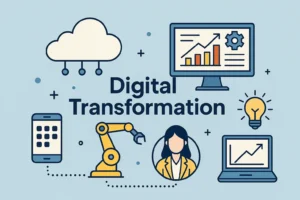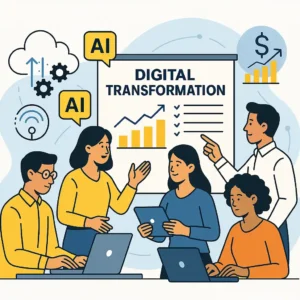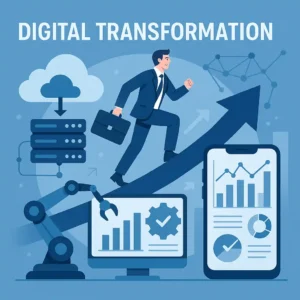What Is Digital Transformation?
Digital transformation refers to the strategic integration of digital technologies into all areas of a business, fundamentally changing how it operates and delivers value to customers. It’s not just about adopting tools like cloud platforms, mobile apps, or artificial intelligence — it’s a complete cultural and operational shift toward continuous innovation, automation, and customer-centric processes.
In the past, businesses could survive without embracing digital technologies. Today, they can’t compete without them. Digital transformation allows companies to respond faster to market demands, improve internal efficiency, deliver seamless customer experiences, and stay resilient in times of crisis — like the COVID-19 pandemic or global supply chain disruptions.
Why Is Digital Transformation Important in 2025?
In 2025, digital transformation is not a trend — it’s a necessity. Companies that delay modernization risk losing relevance in a market that moves faster every day. Here’s why digital transformation matters now more than ever:
- Customer Expectations Have Changed: People expect speed, personalization, and 24/7 service. Digital platforms allow businesses to deliver just that.
- Competition Is Digital-First: Your competitors are using automation, data analytics, and AI to operate smarter. If you’re not, you’re behind.
- Remote and Hybrid Work Are Permanent: Digital infrastructure enables teams to collaborate from anywhere, access data securely, and maintain productivity across time zones.
- Cybersecurity Risks Are Increasing: Outdated systems are vulnerable. Digital transformation includes upgrading security frameworks and data protection.
- Data Drives Strategy: Businesses that harness real-time data can make faster, smarter decisions — and win market share.

The Key Pillars of Digital Transformation
Digital transformation involves much more than “going paperless” or launching a mobile app. It’s a strategic, long-term process that typically includes the following pillars:
1. Digital Tools and Infrastructure
The foundation of transformation is technology. Cloud computing, SaaS (Software as a Service), APIs, and IoT (Internet of Things) enable scalable, integrated systems. Companies no longer rely on local servers — instead, they operate in flexible cloud environments that support remote access, real-time collaboration, and rapid deployment.
2. Process Automation
Automation is central to efficiency. By using tools like robotic process automation (RPA), chatbots, and workflow software, companies eliminate repetitive tasks, reduce human error, and focus talent on strategic initiatives.
Examples include:
- Automating customer onboarding
- Invoice processing with OCR
- Predictive maintenance in manufacturing using IoT sensors
3. Data and Analytics
In the digital era, data is currency. Organizations that implement analytics platforms (like Power BI, Google Looker Studio, or Tableau) gain a real-time understanding of performance, customer behavior, and operational bottlenecks.
Key benefits:
- Forecasting demand
- Improving customer retention
- Reducing supply chain risks
4. Cultural and Organizational Change
True transformation requires more than IT investment. Companies must adopt a culture of agility, experimentation, and learning. This includes:
- Flattened hierarchies
- Empowered cross-functional teams
- Agile methodologies (Scrum, Kanban)
- Continuous training and upskilling
5. Customer Experience (CX)
Digital transformation is meaningless without CX. Businesses must leverage technology to:
- Personalize communication
- Simplify navigation on websites and apps
- Reduce response times through AI-powered support

Examples of Digital Transformation in Real Life
Example 1: Retail — Online Shopping Personalization
Amazon is a textbook case of digital transformation. By using AI to track behavior and suggest products, it has redefined e-commerce. Even small e-commerce businesses now implement dynamic pricing, chatbots, and CRM tools to compete.
Example 2: Banking — Digital-Only Banks
Nubank and Revolut are digital-native banks that have disrupted traditional banking by offering accounts, cards, and loans 100% online, with better UX, fewer fees, and instant support via apps.
Example 3: Manufacturing — Smart Factories
Factories now deploy sensors and connected machinery to monitor performance in real time, forecast equipment failure, and improve safety. This shift is part of the “Industry 4.0” movement.
The Role of AI in Digital Transformation

Artificial intelligence (AI) is at the heart of digital transformation in 2025. It empowers:
- Predictive analytics: anticipating customer behavior
- Chatbots and virtual assistants: improving support with lower cost
- Process optimization: detecting inefficiencies with machine learning
Companies that use AI not only operate faster but also learn and evolve in real time, gaining a significant edge in a crowded market.
Why Some Companies Still Resist — And Fail
Despite clear benefits, many organizations struggle or fail to implement digital transformation due to:
- Legacy systems that are hard to integrate
- Resistance to change at leadership or employee levels
- Short-term mindset (expecting results in weeks)
- Lack of digital skills across the workforce
- Underestimating investment in time, money, and training
Those who continue to ignore digital innovation risk being disrupted by smaller, faster, more agile competitors.

…Successful projects are led by interdisciplinary teams, including:
- IT specialists
- Process managers
- Marketing analysts
- Customer experience professionals
- Project managers
This approach ensures that decisions are not made in isolation and that digital efforts align with multiple departments’ real needs.
4. Start Small, Scale Fast
Trying to digitize an entire company at once is a recipe for failure. Instead, pilot your transformation in one department or workflow, measure the results, refine the approach, and then scale.
Examples of small wins:
- Launch a chatbot to reduce FAQ support tickets
- Automate internal document approvals using a no-code platform
- Use AI to recommend products in your e-commerce store
These quick wins build internal credibility and help justify broader investment.

5. Invest in Upskilling Your Team
Digital transformation fails without people who understand and can operate new tools. Training and upskilling your workforce is a crucial part of the process. Focus on:
- Digital literacy
- Data analysis
- Cloud computing basics
- Cybersecurity awareness
- Remote collaboration skills
Many companies now offer internal “digital academies” or partner with online platforms like Coursera, edX, or LinkedIn Learning to fast-track knowledge.
6. Monitor, Measure, and Iterate
Digital transformation is not a “set and forget” initiative. Your systems, goals, and market are constantly changing. That’s why your strategy needs a feedback loop.
Key elements of this loop:
- Regular performance reporting
- Customer feedback collection
- Agile review meetings
- KPI dashboards for leadership
Adaptation is what separates successful transformation from wasted investment.

7. Focus on User Experience at Every Level
Whether you’re digitizing internal systems or building client-facing apps, user experience (UX) must guide every decision. Bad UX leads to tool rejection, low adoption, and project failure.
Key UX questions to ask:
- Is the new system faster than the old one?
- Can users accomplish tasks with fewer clicks?
- Is onboarding easy and intuitive?
- Does it work on mobile devices?
Simplicity wins. Your tools should serve the user, not frustrate them.
Common Digital Transformation Mistakes to Avoid
Even well-funded companies fall into these traps:
- 🚫 “Technology first” mindset: Buying tools before defining goals.
- 🚫 Ignoring legacy system limitations: Trying to integrate modern software with outdated databases often creates more problems than it solves.
- 🚫 Underestimating the cultural shift: Tech is easy to install. People are harder to change.
- 🚫 No ownership or accountability: When no one “owns” the transformation, progress stalls.
- 🚫 Forgetting the customer: Changes that complicate the customer journey will backfire.
Technologies Driving Digital Transformation in 2025
Digital transformation is only possible because of the rapid evolution of key technologies. These tools are no longer limited to tech giants — they’re increasingly accessible to small businesses, startups, and even solopreneurs.
Let’s look at the most impactful technologies fueling digital transformation today:
1. Cloud Computing
Cloud computing is the backbone of modern business. Platforms like AWS, Microsoft Azure, and Google Cloud allow companies to:
- Store and access data from anywhere
- Scale operations up or down instantly
- Eliminate the need for expensive physical infrastructure
- Deploy apps and services globally in minutes
In 2025, cloud-native is the default. Even legacy companies are migrating to hybrid cloud environments to gain speed and resilience.
2. Artificial Intelligence and Machine Learning
AI has moved beyond hype — it’s now delivering measurable results. Common AI applications include:
- Predictive analytics (e.g., forecasting demand, detecting fraud)
- Chatbots and virtual assistants (reducing support costs)
- Recommendation engines (like those used by Netflix or Amazon)
- Process automation using intelligent decision-making
- Natural language processing (as seen in ChatGPT)
The key is to use AI not as a gimmick, but as a practical tool that solves real problems.
3. Robotic Process Automation (RPA)
RPA uses bots to replicate repetitive human tasks, such as:
- Data entry between systems
- Generating reports
- Processing invoices
- Sending notifications based on triggers
It’s especially powerful in HR, finance, logistics, and compliance-heavy industries.
4. Internet of Things (IoT)
IoT connects physical devices to the internet, allowing real-time data collection and remote control. Examples:
- Sensors in manufacturing that monitor temperature, pressure, and vibrations
- Smart office systems that adjust lighting or temperature based on occupancy
- GPS tracking in logistics and delivery fleets
- Smart meters in utilities
IoT makes the physical world more transparent and manageable.

5. 5G Connectivity
5G networks provide ultra-fast, low-latency internet — which is essential for:
- Real-time data transfer from IoT devices
- Seamless video conferencing and virtual collaboration
- Remote surgeries and telemedicine
- Augmented and virtual reality applications in retail and training
Faster internet unlocks entirely new digital business models.
6. Low-Code and No-Code Platforms
Digital transformation isn’t just for developers anymore. With tools like:
- Zapier
- Airtable
- Webflow
- Bubble
- Outsystems
…non-technical teams can build apps, automate workflows, and launch solutions without writing code.
This democratization of tech boosts innovation, reduces IT bottlenecks, and speeds up delivery.
7. Blockchain and Smart Contracts
While often associated with cryptocurrencies, blockchain has broader applications in:
- Supply chain transparency
- Secure digital identities
- Fraud prevention in finance
- Smart contracts for automated agreements
It’s particularly valuable in industries requiring trust, traceability, and decentralized systems.
8. Augmented Reality (AR) and Virtual Reality (VR)
AR/VR is transforming how companies handle:
- Remote training (e.g., simulations for technicians or doctors)
- Virtual product demos
- Immersive customer experiences
- Architecture and real estate visualization
These technologies are gaining traction beyond gaming — and are expected to grow significantly post-2025.

Digital Transformation in Different Industries
Digital transformation isn’t a one-size-fits-all concept — it varies greatly depending on the industry. Each sector faces unique challenges, regulations, customer behaviors, and operational models. But what they all share is this: companies that embrace digital shift faster, serve better, and grow stronger.
Let’s explore how transformation is reshaping key industries in 2025:
1. Healthcare
Telemedicine, AI diagnostics, and patient data digitization are revolutionizing care delivery.
Key transformations:
- Virtual consultations via secure platforms
- AI-powered triage systems that guide patients to the right treatment faster
- Digital health records accessible across providers
- Wearable devices monitoring heart rate, glucose levels, and more
The result: faster service, fewer errors, and improved patient outcomes — especially in rural or underserved regions.
2. Education
Online learning is now the norm, not the exception. Schools and universities use:
- Learning Management Systems (LMS) like Moodle or Canvas
- Gamified learning to increase engagement
- AI tutors and adaptive learning platforms that adjust to student pace
- Virtual classrooms and collaboration spaces like Google Workspace and Microsoft Teams
Even outside formal education, platforms like Coursera, Udemy, and edX empower lifelong learning for millions globally.
3. Retail and E-commerce
From supply chain to checkout, retail has transformed completely.
Key elements:
- Personalized product recommendations using AI
- Virtual try-on tools using AR (e.g., glasses, shoes, furniture)
- Chatbots assisting in product selection and order tracking
- Automated inventory management with real-time data
- Integration with social commerce (Instagram, TikTok shops)
Retailers that don’t offer speed, personalization, and convenience are left behind.
4. Financial Services
Banks and fintechs are in a race to digitize — and the customer is winning.
Examples:
- Digital-only banks (like Revolut, Nubank)
- Instant loan approvals using AI scoring models
- Blockchain for secure, low-fee international transfers
- Chatbots replacing human agents for everyday tasks
- Biometric authentication via facial recognition or fingerprint
Security is also front and center, with zero-trust architectures and multi-factor authentication becoming standard.

5. Logistics and Supply Chain
Efficiency and transparency are vital in this space. Companies now use:
- Real-time GPS tracking for deliveries
- Predictive analytics to forecast delays
- Warehouse automation with robots and drones
- IoT sensors monitoring temperature and location of goods
- Blockchain for end-to-end product traceability
Digital transformation reduces waste, enhances reliability, and helps businesses navigate global disruptions.
6. Manufacturing
Industry 4.0 is not just a buzzword — it’s the foundation of smart manufacturing.
Innovations include:
- Digital twins: virtual replicas of machines used for testing and optimization
- Predictive maintenance: AI detects when machines will fail before they actually do
- 3D printing for custom parts and rapid prototyping
- Robotics and automation on assembly lines
- Edge computing to analyze data closer to machines for real-time decision-making
This leads to faster production cycles, fewer defects, and better resource use.
7. Real Estate
Even real estate is going digital:
- Virtual tours via 3D walkthroughs and VR
- Digital signatures for contracts
- AI-driven property valuations
- Platforms connecting buyers, sellers, and agents in real time
- Smart buildings using IoT for energy efficiency and security
It’s no longer enough to list a property — success means delivering digital convenience and speed.

The Benefits of Embracing Digital Transformation
Companies that fully embrace digital transformation experience benefits that go far beyond operational improvements. It’s not just about working faster or cheaper — it’s about creating a resilient, scalable, and customer-centric organization.
Let’s explore the biggest advantages of going digital in 2025:
1. Increased Agility and Speed
In a digital environment, businesses can:
- Launch products faster
- Pivot strategies in response to market changes
- Test and deploy new campaigns or features in real time
- Scale operations instantly using cloud resources
Agility is the difference between reacting in months… or minutes.
2. Better Customer Experience (CX)
Digital-first companies build personalized, seamless journeys across all channels — web, mobile, chat, and in-store.
Benefits:
- Predictive support (anticipating issues before they happen)
- Personalized offers and messaging
- Omnichannel communication (e.g., email + WhatsApp + chatbot)
- 24/7 service availability through automation
When customers are happy, retention increases — and so does lifetime value.
3. Improved Employee Productivity
With the right digital tools, teams can:
- Eliminate redundant manual tasks
- Collaborate asynchronously from anywhere
- Access knowledge bases and shared data easily
- Automate internal requests and workflows (e.g., vacation approvals, expense reports)
Engaged employees waste less time and feel more empowered — reducing burnout and turnover.
4. Enhanced Data-Driven Decision Making
Data is at the heart of transformation. Modern tools provide:
- Real-time dashboards
- Predictive modeling
- Customer segmentation
- Inventory forecasting
- Financial trend analysis
This makes decision-making faster, more accurate, and grounded in facts — not guesswork.
5. Lower Operational Costs (Over Time)
While the upfront investment in digital tools, training, and infrastructure can be significant, the long-term ROI is massive. Companies that digitize:
- Reduce paper and printing
- Automate recurring work
- Avoid costly human errors
- Save on real estate via hybrid teams
- Detect inefficiencies earlier
Automation doesn’t replace people — it amplifies their impact.
6. Competitive Advantage
Digital leaders outperform their competitors in every key area:
| Metric | Traditional Firms | Digitally Transformed |
|---|---|---|
| Time to market | Slow | Fast |
| Customer satisfaction | Moderate | High |
| Innovation speed | Low | Continuous |
| Adaptability | Limited | Agile |
| Talent attraction | Difficult | Strong |
Your digital maturity is now a core part of your brand reputation.
7. Stronger Resilience in Crises
The pandemic proved that businesses with cloud systems, remote-ready teams, and digital sales channels were the most resilient. Digital transformation builds:
- Business continuity plans
- Distributed infrastructure
- Secure, redundant data storage
- Flexible work arrangements
- Automated recovery protocols
You don’t just survive crises — you thrive through them.
8. Better ESG and Sustainability Alignment
Environmental, Social, and Governance (ESG) metrics are now a priority. Digital transformation helps by:
- Reducing paper waste
- Improving energy efficiency via smart buildings
- Enabling remote work (cutting emissions)
- Enhancing transparency in supply chains
- Digitizing compliance documentation
Sustainability is no longer optional — and going digital is a step in the right direction.
How to Measure the Success of Digital Transformation
Implementing digital transformation is one thing — but measuring its impact is where most companies get stuck. In 2025, businesses must quantify transformation not just by how many tools they’ve adopted, but by the value those tools deliver.
Here’s how to track real success:
1. Define Clear KPIs from the Start
Before launching a single project, leadership must define key performance indicators (KPIs) that align with strategic goals.
Examples include:
- Website speed and conversion rates
- Time to deliver a service or product
- Customer satisfaction scores (CSAT, NPS)
- Support ticket resolution time
- Churn rate reduction
- Cost savings from automation
These metrics should be tied to both short-term wins and long-term transformation objectives.
2. Monitor User Adoption Rates
If employees don’t use the new systems, they’re worthless. Track metrics like:
- Daily active users of new platforms
- Time spent on digital tools vs. legacy systems
- Completion of training programs
- Feedback surveys on usability and performance
Poor adoption is a red flag — it means the tools weren’t designed with the user in mind or change management failed.
3. Analyze Operational Efficiency
After going digital, are you doing more with less?
Compare:
- Process completion times
- Staffing requirements for repetitive tasks
- Volume of manual data entry or paperwork
- Frequency of human error in workflows
Improved internal efficiency is one of the most immediate benefits you should notice.
4. Evaluate ROI Over Time
Don’t expect instant ROI. Digital transformation delivers exponential value — but only when well-implemented and aligned with growth goals.
Track:
- Revenue growth in digital channels
- Reduction in service delivery costs
- Customer lifetime value (CLV)
- Retention rates post-implementation
Tools like Power BI, Looker Studio, and Tableau are essential to visualize this data and communicate it across teams.
5. Customer Feedback and Experience Data
Technology must improve customer outcomes — not complicate them.
Use tools like:
- Post-service surveys
- NPS (Net Promoter Score)
- Behavioral analytics (heatmaps, session recordings)
- Support chatbot ratings
- App store reviews and response rates
Real transformation is reflected in the way your customers respond — and stay loyal.
6. Benchmark Against Competitors
Is your digital maturity keeping up with — or surpassing — the competition?
Consider industry-specific benchmarks, published digital indexes, or external digital audits to understand where you stand. Look at:
- Automation rate vs. competitors
- App performance ratings
- Web Core Vitals
- Brand sentiment online
- Speed of launching new services
Being digitally behind doesn’t just cost money — it erodes your reputation.
The Cost of Ignoring Digital Transformation
While much has been said about the benefits of digital transformation, it’s equally important to understand the risks and losses that come from ignoring it. In 2025, standing still is the same as falling behind — and businesses that resist digital change are putting their future at risk.
Here’s what can happen when companies delay or deny transformation:
1. Loss of Market Share
Customers expect speed, personalization, mobile access, and frictionless service. Companies that fail to deliver these experiences will lose customers to competitors who do. Brand loyalty is fragile in the digital age, and switching costs are lower than ever.
Examples:
- Traditional retailers losing to e-commerce
- Banks losing accounts to fintechs
- Cable TV providers losing subscribers to streaming platforms
2. Talent Drain
Modern employees, especially Millennials and Gen Z, prefer to work in digitally mature environments. They value remote flexibility, collaboration tools, and innovative culture.
A company with outdated systems may:
- Struggle to attract top talent
- See higher employee turnover
- Spend more on recruitment and training
- Suffer from low engagement and productivity
Digital tools don’t just help retain talent — they help unlock their potential.
3. Increased Operational Costs
Manual processes, paper systems, physical infrastructure — all these legacy models are expensive to maintain. Digitally lagging companies face:
- Higher cost per transaction
- More errors and rework
- Longer cycle times for decision-making
- Redundant or siloed systems
The longer you wait, the more expensive the gap becomes to close.
4. Inability to Scale
Without digital infrastructure, scaling operations — whether local or global — becomes slow, chaotic, or even impossible.
You may encounter:
- Capacity limits in legacy tools
- Integration problems with new partners
- Bottlenecks in service delivery
- Inflexible systems that resist adaptation
Digital transformation removes friction and allows growth to happen in real time.
5. Poor Crisis Response
Crises — economic, political, environmental, or health-related — are inevitable. In 2020, the pandemic exposed how unprepared many companies were. Businesses without digital capabilities:
- Couldn’t shift to remote work
- Lost visibility into supply chains
- Had no digital sales channels
- Struggled with customer service demand
Digital maturity is now part of your resilience strategy. It’s not just about growing — it’s about surviving.
6. Lower Valuation and Investor Interest
In today’s financial world, digital transformation affects company valuation. Investors and stakeholders assess digital capabilities as a core asset.
Companies seen as technologically outdated may:
- Struggle to raise capital
- Get poor ratings in ESG or innovation benchmarks
- Be bypassed in M&A opportunities
- Be labeled as high-risk or obsolete
Your digital presence is part of your brand’s equity — and its long-term value.
7. Irrelevance in the Digital Economy
At a certain point, being offline, slow, or paper-based doesn’t just mean inefficiency — it means irrelevance. If your customers are digital-first, your business must be too.
This doesn’t require every company to become a tech giant. But it does require:
- Core systems online
- Data-driven insights
- Digital communication channels
- Secure, scalable infrastructure
Final Words: Digital Transformation Is the New Standard
In 2025, digital transformation is not optional — it’s the baseline. It’s what enables your business to evolve with your customers, defend against disruption, attract top talent, and build lasting value.
Whether you’re just beginning or optimizing your current strategy, what matters most is action. Transformation is not a project. It’s a mindset — a continuous journey of learning, improving, and adapting.
You don’t need to master every tool or trend overnight. Start with small, focused changes. Measure your impact. Listen to your users. Keep going.
Because in the digital economy, those who evolve lead — and those who delay disappear.
A deeper understanding of global digital transformation trends can be found in the research conducted by the World Economic Forum. Their insights explore how industries are changing, what technologies are leading the change, and how businesses can adapt responsibly and inclusively.
Source: https://www.weforum.org/agenda/archive/digital-transformation
The Future of Business in a Digitally Transformed World
The digital landscape is not just evolving — it is accelerating. Businesses that embrace this momentum position themselves for sustained relevance, agility, and leadership. But what exactly does the future hold for organizations that successfully undergo this transformation? More importantly, how can they maintain this momentum after their initial steps?
Continuous Adaptation Is the New Competitive Advantage
In a world driven by digital disruption, stability has a new definition: the ability to adapt. Organizations that remain flexible — in processes, teams, and technologies — can pivot faster when market conditions shift.
We’re seeing this play out across all sectors. Retailers are redesigning supply chains using predictive modeling. Manufacturers are updating legacy equipment with IoT sensors to monitor output in real time. Education platforms are offering customized learning paths based on user behavior and outcomes.
These are not one-time upgrades — they are systems built to evolve.
Employee Empowerment Through Smart Tools
While automation often raises concerns about job loss, the reality is more nuanced. Digital solutions free up teams from repetitive, low-impact tasks, enabling them to focus on problem-solving, creativity, and collaboration.
With platforms like Notion, Trello, and Miro becoming standard across industries, professionals are gaining new ways to contribute and share knowledge. In customer service, for example, chatbots handle routine queries, while humans focus on empathetic, complex support.
Companies that prioritize digital literacy and internal upskilling benefit from a workforce that’s not only capable but deeply engaged.
Customer-Centric Innovation Is the Baseline
Today’s consumers expect seamless, personalized experiences across channels — and businesses that cannot deliver them risk losing attention (and revenue).
Voice search, smart assistants, and biometric authentication are already reshaping how people interact with digital systems. From frictionless checkout processes to apps that anticipate user needs based on behavior patterns, personalization is no longer a “plus” — it’s required.
The future will demand innovation that starts with listening: what customers want, how they behave, and what problems they’re trying to solve.
Ecosystems and Partnerships Will Define Growth
Gone are the days of siloed success. In 2025 and beyond, business growth will be powered by networks — not just internal capabilities. Open APIs, integrations, and collaborative platforms are already enabling even small businesses to act globally and scale efficiently.
Partnerships with fintech platforms, logistics providers, data analysts, and even AI model marketplaces allow companies to extend capabilities without building everything in-house.
The ability to choose and integrate the right tools — quickly and securely — becomes a key business advantage.
Ethical Tech Practices Are Non-Negotiable
With increased digital power comes greater responsibility. Consumers, regulators, and investors are placing new pressures on companies to operate ethically in their digital strategies.
This includes:
- Transparent data collection practices
- Inclusive design (accessibility for all users)
- Responsible AI development
- Clear governance over automation and content moderation
- Environmental sustainability in cloud infrastructure and device use
Firms that embrace ethical principles as part of their digital identity are not only building trust — they’re future-proofing their brand.
Cybersecurity Is a Strategic Foundation
Cyber threats are not just more frequent — they’re more sophisticated. As systems become interconnected and data becomes more valuable, every point of access becomes a potential vulnerability.
Leaders are now investing in:
- Zero-trust architecture
- Continuous authentication protocols
- Cyber awareness training for employees
- AI-driven threat detection
- Cloud-based backup and disaster recovery solutions
Security is no longer an IT issue — it’s a core business concern, and it must be treated as such in the boardroom.
Data Intelligence Will Drive Hyper-Personalization
The companies that win tomorrow are the ones who best understand their users today.
This doesn’t just mean collecting data — it means using it intelligently. Real-time analytics, behavioral tracking, and AI forecasting allow for proactive, not reactive, business models.
Consider e-commerce platforms that adjust pricing dynamically or streaming services that curate recommendations per household. These aren’t futuristic ideas — they are happening now, and they’re expanding across sectors.
Businesses need to invest not only in data capture but in tools and people capable of translating that data into action.
Remote Work Is No Longer a Trend — It’s Infrastructure
Even companies that have returned to the office are building systems assuming hybrid flexibility. The infrastructure to support remote work — cloud storage, asynchronous communication, virtual collaboration tools — is no longer optional.
Moreover, this infrastructure is becoming a core component of business continuity. Whether facing a global crisis or simply expanding talent pools across borders, remote-readiness is a competitive edge.
Asynchronous video updates, team dashboards, and cross-time-zone project tools are making this shift not only manageable — but more productive than ever before.
Human-Centered Design Will Win Long Term
All technology must serve people first. This principle applies to every interface, every tool, and every strategy within a digitally mature organization.
Design thinking, user journey mapping, and empathy-led UX are more than buzzwords — they’re essential for digital adoption. If the interface is clunky, if the onboarding is confusing, or if the experience isn’t intuitive, even the best tools will fail.
Great digital systems don’t just work — they feel natural to use.
Resilience Through Innovation
Perhaps the most powerful result of digital maturity is this: resilience. Businesses that integrate change at their core — through people, platforms, and processes — are better equipped to weather disruptions and seize new opportunities.
When challenges arise — be it market instability, geopolitical uncertainty, or supply chain shifts — these companies don’t pause. They adapt. They pivot. They lead.
That’s the promise of building for the future: not just surviving change, but using it to thrive.
How Small and Medium Enterprises Are Leading the Digital Shift
When digital maturity is discussed, the spotlight often falls on global corporations and tech giants. However, some of the most inspiring progress in this space is happening within small and medium-sized enterprises (SMEs). These businesses, though limited in scale and budget, are proving that meaningful change doesn’t require massive investment — only strategic vision and execution.
Agility and Speed as a Natural Advantage
One of the biggest assets SMEs have is their size. Unlike larger organizations with complex hierarchies and bureaucratic approval processes, smaller companies can act quickly. This agility allows them to adopt tools, experiment with workflows, and respond to customer feedback in a matter of days or weeks — not quarters.
For instance, a boutique marketing agency can integrate project management platforms like Asana or ClickUp to automate client communication. A local fitness studio can launch online memberships using Stripe, Zoom, and a no-code landing page tool — all within one week.
This speed becomes a competitive edge, especially in crowded markets.
Cost-Effective Tools Are Closing the Gap
The democratization of software has leveled the playing field. Cloud-based tools with tiered pricing models now make it possible for smaller players to access the same features that were once reserved for enterprise-level companies.
SMEs today are using:
- CRM platforms like HubSpot and Zoho to manage sales and leads
- Email marketing tools like MailerLite and ConvertKit for audience engagement
- Online accounting software like QuickBooks or Wave to manage finances
- E-commerce platforms like Shopify or Wix to sell products globally
- Low-code apps like Glide or Softr to build internal tools and portals
The cost barrier is no longer the major blocker. It’s the mindset — and SMEs that embrace experimentation tend to benefit the fastest.
Local Focus, Global Reach
One powerful outcome of digitization for SMEs is the ability to break geographical limitations. A niche product or specialized service that once served only local customers can now be promoted to international audiences with the right strategy.
Social media advertising, influencer partnerships, SEO-optimized websites, and global shipping logistics have opened new revenue streams. For example, independent artisans are selling handmade goods across borders via Etsy. Consultants are offering services via Zoom to clients in multiple time zones.
This expansion is not reserved for venture-backed startups — it’s happening in small warehouses, coffee shops, and home offices around the world.
Personalized Customer Experience at Scale
What SMEs lack in volume, they often compensate for in personalization. Smaller teams are more likely to have direct relationships with their customers, and digital tools only amplify this.
With data collected through CRMs, email analytics, and chat integrations, businesses can understand customer behavior and preferences. They can tailor offers, anticipate needs, and proactively follow up with solutions — often faster and more naturally than big corporations.
For instance:
- A craft beer company might use WhatsApp groups to notify loyal customers of limited releases.
- A neighborhood bakery might automate birthday discount emails using customer purchase history.
- A freelance designer might offer personalized project updates via Loom videos instead of generic emails.
Technology doesn’t have to remove the human element — it can enhance it when used thoughtfully.
Building Culture Around Innovation
For many SMEs, transformation is not just about adopting tools — it’s about embracing change as part of the company culture. Teams are encouraged to test new platforms, suggest process improvements, and learn digital skills that go beyond their job titles.
Workshops on automation, internal Slack channels for tool reviews, or “no-code Fridays” where employees prototype solutions — these practices promote innovation from the ground up.
This culture also makes it easier to attract younger, tech-savvy professionals who value autonomy and growth. In many ways, the SME environment becomes a proving ground for future digital leaders.
Overcoming Challenges Without Traditional Resources
Of course, digital adoption in small businesses doesn’t come without obstacles. Lack of in-house IT support, limited training resources, and uncertainty about which tools to choose are all common hurdles.
However, the internet has provided powerful answers:
- Free tutorials on platforms like YouTube and Coursera
- Communities on Reddit, Facebook Groups, and LinkedIn where business owners share tool reviews and strategies
- Support from software companies themselves, offering onboarding and success teams even on lower-tier plans
Rather than viewing these constraints as limitations, many SMEs use them as opportunities to simplify, streamline, and focus only on what delivers value.
Compliance and Security Awareness Is Growing
Traditionally, cybersecurity and regulatory compliance have been seen as enterprise concerns. But with increasing digital dependency, even small businesses are becoming aware of risks.
Many are taking steps like:
- Enabling two-factor authentication across accounts
- Using password managers and encrypted storage tools
- Complying with data privacy laws like GDPR when handling international customers
- Choosing SaaS vendors with ISO or SOC certifications
Even basic steps like employee training on phishing attacks or regular software updates contribute significantly to a more resilient operation.
SME Stories That Inspire
Consider these examples:
- A small English-language tutoring center in Brazil transformed into a global edtech platform by using Google Meet, Calendly, and Stripe.
- A family-run bakery in the Netherlands doubled its revenue by launching an online ordering system and leveraging Instagram Reels.
- A Kenyan freelance agency used Trello, Notion, and Payoneer to serve clients across Europe and North America, growing their team from 2 to 15 people in under a year.
These are not unicorn startups. They are small operations led by people who decided to rethink their workflows, optimize their touchpoints, and serve customers more effectively using digital tools.
What Large Enterprises Can Learn from Small Businesses
Ironically, larger organizations often struggle with the very things that SMEs do best — agility, personal service, quick iteration, and internal empowerment.
This is why many enterprises are adopting “startup within a company” models — building small, autonomous teams with their own budgets and goals to recreate that nimble SME environment inside larger systems.
The truth is, transformation is not about company size — it’s about intent and execution.
FAQ Section
Q1: What is digital transformation in simple terms?
A: Digital transformation is the process of using digital technologies to improve business operations, customer experiences, and company culture. It means moving away from manual and outdated systems to more efficient, data-driven, and automated processes.
Q2: Why is digital transformation important in 2025?
A: In 2025, digital transformation is essential because customer expectations, global competition, and cybersecurity risks are higher than ever. Companies need digital tools to stay agile, deliver value faster, and remain competitive in a fast-moving economy.
Q3: What technologies drive digital transformation?
A: Key technologies include cloud computing, artificial intelligence (AI), machine learning, IoT (Internet of Things), low-code/no-code platforms, 5G connectivity, and robotic process automation (RPA).
Q4: What industries are being transformed by digital tools?
A: Virtually all industries — including healthcare, education, finance, retail, manufacturing, logistics, and real estate — are undergoing major digital transformation.
Q5: What are the biggest challenges in digital transformation?
A: Common challenges include resistance to change, legacy systems, lack of digital skills, unclear strategy, and low user adoption of new tools.
Final Thoughts: Keep Evolving, Stay Competitive
Digital transformation isn’t just about technology — it’s about improving people, processes, and the way we understand the workplace itself. That’s why many companies begin their digital journey with internal tools like employee surveys and feedback forms.
If you’re exploring ways to digitize your team’s performance evaluation and engagement processes, take a look at our guide on how to create an organizational climate survey using Google Forms. It’s a hands-on resource that shows how even a simple Google Form can drive meaningful change inside your organization.
Your transformation can start with something small — as long as you start.









 por LuxStudio
por LuxStudio